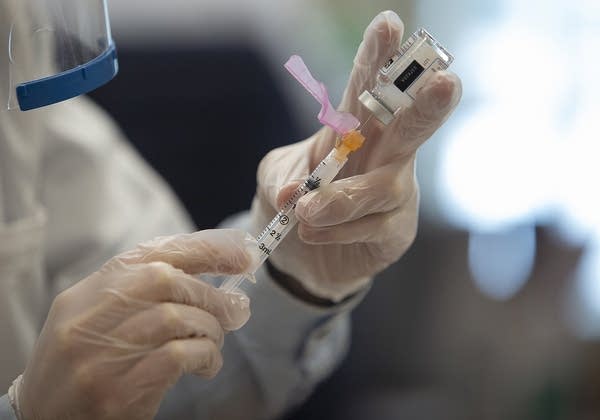After slow start, Minnesota long-term care centers get more vaccinations

Like this?
Log in to share your opinion with MPR News and add it to your profile.
Like this?
Thanks for liking this story! We have added it to a list of your favorite stories.
A federal COVID-19 vaccine program for Minnesota’s most vulnerable people is going more slowly than expected. Two national chains, Walgreens and CVS, are part of a program to vaccinate residents and staff in a majority of the long-term care facilities.
In late December, when vaccinations began at Minnesota’s nursing homes, the state said that people in more than 2,000 long-term care facilities should have their first vaccine doses by the end of January.
While nursing homes across the state are mostly finished with first doses and are moving onto their second, the program for the much larger group of assisted living facilities is still going.
The pace of the rollout led Gov. Tim Walz to announce last week the state would take vaccine doses away from providers and reallocate them to other vaccination efforts if they did not dispense all doses in a week, with most used within 72 hours.
Support the News you Need
Gifts from individuals keep MPR News accessible to all - free of paywalls and barriers.
According to data from the two companies as of Monday, Walgreens has given first doses to 50 percent of the 779 facilities it’s been assigned and CVS has given them to about 90 percent of the 478 it was assigned. Both those percentages increased over the weekend.
A pharmacy partnership program with the Centers for Disease Control and Prevention required states, including Minnesota, to bank doses needed for long-term care facilities.
Kris Ehresmann, infectious disease division director at the Minnesota Department of Health, said instead of using the vaccine as it was shipped, thousands of doses had been sitting in cold storage unused.
“This program has been challenging and frustrating, because the number of doses that are allocated both those first and second doses have certainly weighed on our average in terms of doses administered,” she said.
In an interview with Axios, Walz said that in retrospect, the state could have turned away from the federal partnership program. He said he believed former President Donald Trump would punish governors who opted out of it.
There are states with similar numbers of facilities where the first round of doses in assisted living facilities is complete or nearly complete. Ehresmann said some regions of the country performed better than others.
“This has been coordinated at the federal level, but there are regional teams that are responsible for, say, a given state.” Ehresmann added how regional teams operate can affect vaccine programs.
Both Walgreens and CVS declined requests for interviews.
A third company, the regional chain Thrifty White, is also part of the federal partnership.
Gayle Kvenvold, CEO of LeadingAge Minnesota, which represents many long-term care facilities across the state, said the vaccine program is improving.
“We obviously are eager to see the vaccine clinics occur as efficiently and quickly as possible for those who live and work in our settings. And we feel like we are making steady progress now,“ Kvenvold said.
According to state officials, Walgreens will vaccinate at 135 homes this week, CVS has 75 sites over the same time period.
The Minnesota database that includes assisted living also includes a wide variety of facilities including drug treatment and mental health, so determining what qualified as homes for older people also slowed the process.
Ehresmann said they are trying to balance making sure people most likely to die of COVID-19 are still getting their vaccines, but that as many people as possible have access. It took longer to vaccinate people at some long-term care facilities, especially when getting permission from family was involved.
“We have to both think about being as efficient as possible, and also recognize that facilities, families, residents and staff have to have some time to plan,” Ehresmann said.
The Walz administration decided to tap into the stockpile for CVS and Walgreens and instead give them what they need for each week. The excess doses, around 19,000 this week, are going to other providers to vaccinate people 65 and older and educators.


